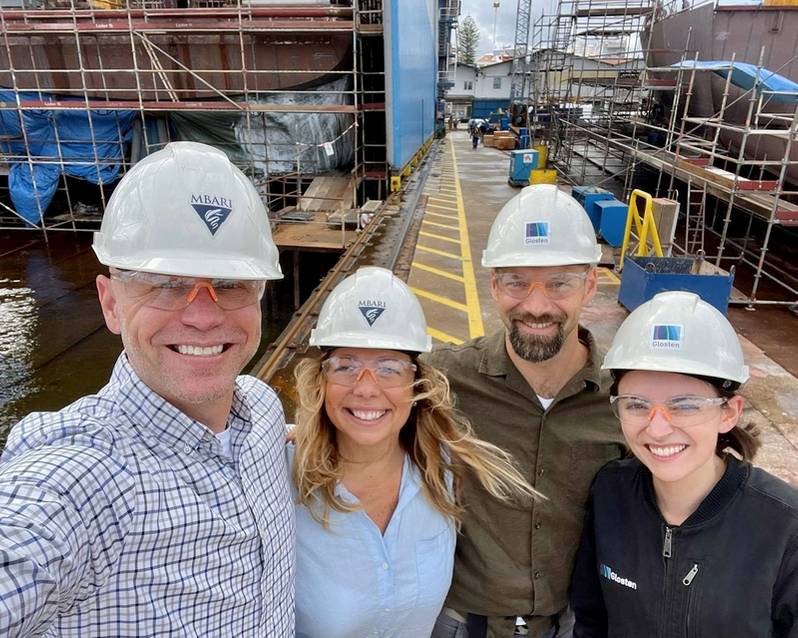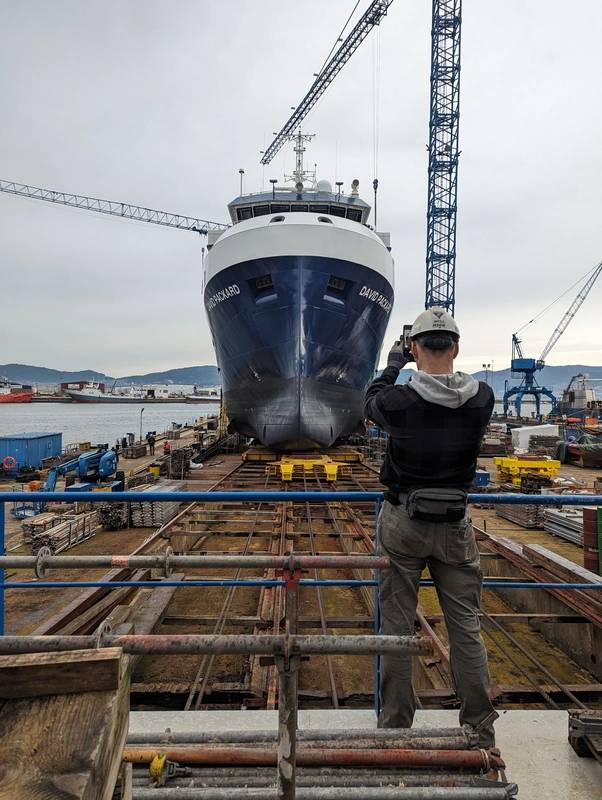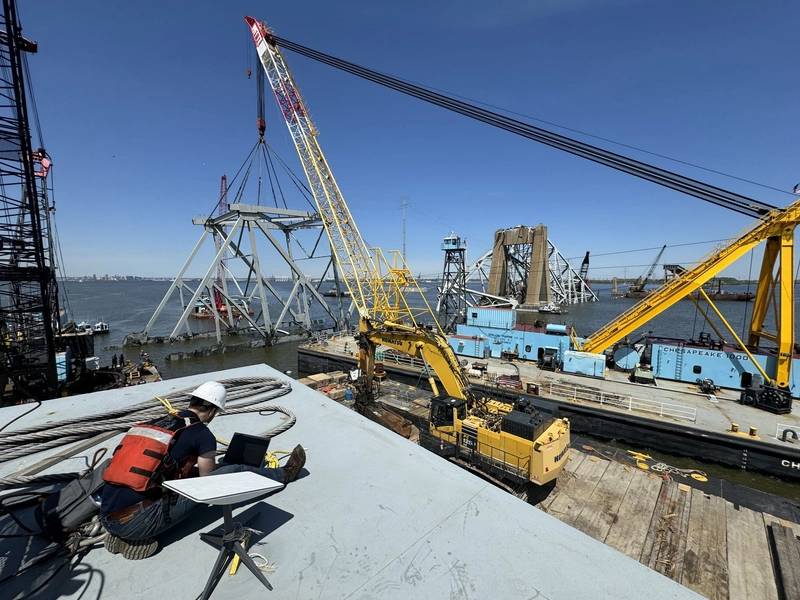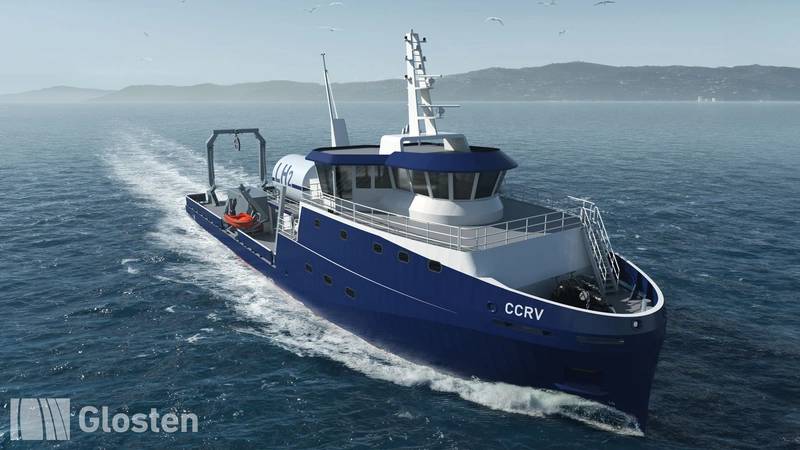The ‘Boat Nerds’ Ringleader – Morgan Fanberg, CEO, Glosten
When he joined Glosten more than 26 years ago as an intern, little did Morgan Fanberg know that one day he’d be at the helm leading one of the largest privately owned naval architecture firm in the United States. But this USMMA-grad was well outfitted for the task, and in this Maritime Matters: The Marinelink Podcast, Fanberg’s passion for the maritime industry and his company is clear as he candidly discusses the challenges he, his team and the maritime industry face in meeting legislatively mandated goals; plus adopting new fuels into new designs while keeping to his mantra to “keep old boats running.”
The maritime industry is filled with executives that have an internal passion for the business that has driven their careers … then there’s Morgan Fanberg, CEO of Glosten who takes it to the next level: Glosten is the only place that Fanberg has worked to date, and apparently, it’s the only place he’d like to work.
“I like to say we’re a bunch of boat nerds, to tell you the truth,” said Fanberg on the Maritime Matters: The Marinelink Podcast. “And that’s not just our engineering staff, it’s also our administrative staff.”
Today Glosten is just north of 120 employees – roughly half of which are employee/owners. Glosten has been in business for more than 67 years, and cumulatively it has worked more than 10,000 projects in 20 different countries. One of the biggest upgrades to the organization in recent years was the acquisition of Noise Control Engineering, a wholly owned subsidiary of Glosten that specializes in habitability, noise abatement, underwater radiated noise mitigation and vibration issues. The Glosten team on site at Freire Shipyard.
The Glosten team on site at Freire Shipyard.
Image courtesy Glosten
Since 1998
Fanberg jokes that one of the biggest changes during his tenure is that “when I started, I had a full head of hair! I love my job; this company has been amazing to work for. But I joke with people, too, because I’ve never worked anywhere else. I always have to remind people, when I talk about how great it is to work here, just be aware I’ve never worked anywhere else … but it is great to work here!”
When reflecting on the change that has happened during that time, he cites the speed of technological evolution and the resulting significant growth of Glosten itself.
“We are engaged in projects worldwide, we embrace new technologies, an we’ve added a lot more expertise, because I think the challenges in the marine industry have gotten more complex than they were 26 years ago,” said Fanberg. “Not that we didn’t have difficult problems then, but the level of technology and the advancement of technology in that rapid advancement has really pushed us to take on more expertise and grow from simple marine engineering and naval architecture.”
But even with the rapid pace of technology and growth, Glosten remain firmly rooted with a focus on safety, reliability, and efficiency. “Whether it’s a naval architect company or an operator, I think those pillars have not changed one bit. If anything, they’ve grown stronger,” said Fanberg. “When I started 26 years ago in the industry, we used to joke about the marine industry being one of the last industries on the planet that would adopt new technology. That has completely changed. You couldn’t ask for a better time to be a naval architect or a marine engineer, because of the challenges we’re facing.”
Grounded, too, is Fanberg and the Glosten team’s focus on problem solving for the client.
“You don’t know exactly where the clients are going to take you, or what problems they’re asking you to solve, so I think we need to be a lot more flexible,” said Fanberg. While requests from individual companies may vary, when looking at the industry as a whole, Fanberg sees out the porthole window that the biggest challenge is, and will remain, decarbonization.
“In 2020, I had a distinct privilege to speak in front of Congress about this move to decarbonize,” said Fanberg. Part of that testimony was about the support private industry needed from government in this change. “If you think about how long it took to go from steam to diesel, that encompassed decades, maybe a century really. And now what we’re talking about is moving away from fossil fuels in a fraction of that time,” said Fanberg.
“This energy transition is profoundly transforming our work,” said Fanberg, noting the recent approval from ABS of a hydrogen hybrid research vessel for the Scripps Institution of Oceanography. “There’s no question that this shift towards future fuels and renewable energy sources goes beyond meeting regulatory pressures. It really reflects our vision to lead the maritime industry in sustainable practices.
 MBARI David Packard at Freire. Image courtesy Glosten
MBARI David Packard at Freire. Image courtesy Glosten
Tools of the Trade
Picking favorites can be difficult, and when asked to identify the one tool that has helped to make his job more efficient and effective, Fanberg found it challenging to narrow down his selection to just one.
“That’s a fantastic question, but actually very difficult to come up with just one tool, to tell you the truth,” said Fanberg, noting that something as simple as the cell phone, and the ability to communicate with working teams in the field, could easily make the top two. “Remember, we used to use phones in hotels to call people. I mean, I don’t even know why they have phones in hotels anymore,” said Fanberg.
But when pressed, he named computational fluid dynamics (CFD). “CFD has revolutionized the way naval architecture can be done today,” said Fanberg. “I’m not trying to diminish the value of doing real model testing; what I’m saying is that based on the cost of using CFD, we can do a lot of work within the office to optimize designs today using a tool that used to be outrageously expensive and required a ton of computing power. We’ve been able to adapt CFD more and more into every design tool at a very efficient price point for our clients.”
Scanning technology, too, is close to the top, “another area that has completely revolutionized; I mean, it used to be tape measures and film, using cameras with film that took a week to process,” said Fanberg. “Now we take the scanner wherever we go; it’s not a question, it’s a part of a process.” Glosten played a key role in the clean-up of the Baltimore bridge collapse.
Glosten played a key role in the clean-up of the Baltimore bridge collapse.
Image courtesy Glosten
Working Today, Planning Tomorrow
The maritime sector today faces challenges that are often as clear as they are fuzzy: For example, in the here and now, the vast majority of assets still run on diesel fuel; yet stakeholders working toward decarbonization goals must plan for an uncertain future premised on not only the dominate maritime fuel that will be used, but also the timeline of its wide availability.
“On one level, yes, there is a push on just about all of our clients to clean the environment and to decarbonize,” said Fanberg. However, that doesn’t necessarily mean a new vessel, “partially because you might not need a new vessel, but also the outrageous cost to recapitalize and build new,” said Fanberg.
The conversations with most owners start with modifications that can be enacted on the existing fleet to offer some incremental change to meet requirements and get them through the next 5-10 years. This is understandable given the capital expenditure required to build the original boat or ship. Earlier this year Glosten was awarded an Approval in Principle (AIP) by the American Bureau of Shipping (ABS) for the design of UC San Diego’s new hydrogen-hybrid Coastal-Class Research Vessel (CCRV). Image courtesy Glosten
Earlier this year Glosten was awarded an Approval in Principle (AIP) by the American Bureau of Shipping (ABS) for the design of UC San Diego’s new hydrogen-hybrid Coastal-Class Research Vessel (CCRV). Image courtesy Glosten
“That means we have to be very broad in our capabilities,” said Fanberg. “It’s not just all about new vessel designs and alternative fuels. The other part of that equation is: ‘I have an old boat that I need to get 10 more years out of, I have these regulations that I need to meet … help me do that.’ In some cases the even bigger challenge is to keep old boats running,” said Fanberg.
One area in new design that Glosten historically has excelled in is the global research vessel market, a small but highly specialized sector where its acquisition of Noise Control Engineering really comes into play.
Earlier this year Glosten was awarded an Approval in Principle (AIP) by the American Bureau of Shipping (ABS) for the design of UC San Diego’s new hydrogen-hybrid Coastal-Class Research Vessel (CCRV). The CCRV will be operated by Scripps Institution of Oceanography and feature a propulsion system that uses hydrogen fuel cells for zero-emissions operation. Glosten and the project’s electrical integrator, Siemens Energy (SE), completed the preliminary design for the CCRV in March 2024. As an uninspected, California Air Resource Board (CARB)-compliant, ABS-classed vessel and an alternative design under SOLAS, the CCRV faced a complex regulatory regime.
Prior to submitting the design for AIP, Glosten completed a week-long risk assessment workshop with the USCG, Scripps, SE, and major equipment providers, Ballard Power Systems and Chart Industries.
“We started doing work for the research industry quite a while ago,” noting its design of the FLIP vessel.
The iconic Floating Instrument Platform (FLIP) — was officially retired from service in 2023. Built in 1962 with funding from the Office of Naval Research (ONR), FLIP helped generations of scientists and oceanographers better understand the mysteries of the sea, including internal waves, air-sea interaction and long-range sound propagation. FLIP was owned by the U.S. Navy and managed by Scripps Institution of Oceanography at UCSD.
“It’s a fascinating vessel, and Larry Glosten with FLIP solidified our spot with the research community,” said Fanberg.
“Research vessels are extremely complex and difficult to design, and it’s because scientists want their vessel to be able to do everything in a small package. And to do that, it requires a lot of effort on our engineering side using new design tools to basically go further with our engineering design and to make sure that no details are left unknown.”
Strategically, involvement in the research vessel community has helped Glosten to compete globally. “It’s difficult for a US-based firm to compete on the global market, make no mistake about it,” said Fanberg. “But when it comes to this level of complexity, it highlighted our ability to compete more broadly. Our avenue going global was really on the backs of our research vessel capabilities,” a development that has also helped Glosten to find new clients in other sectors who also have complex engineering problems to solve.”






















